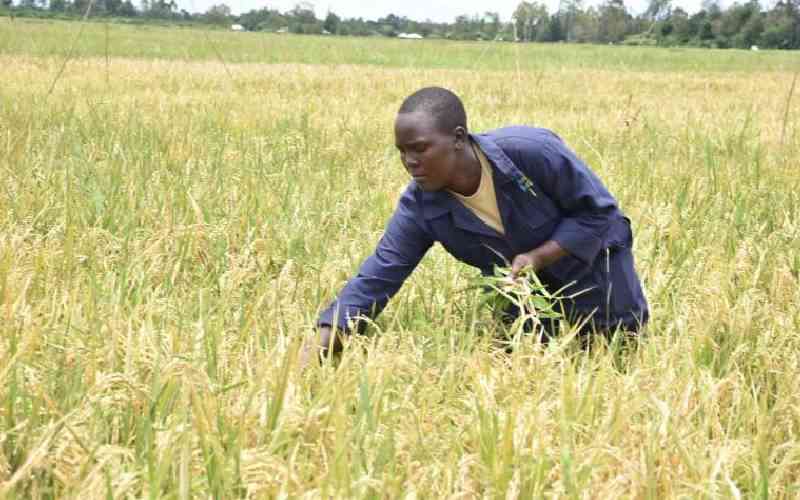By BETTY MAINA
Kariuki has a thriving pig business. Or more appropriately — did. He is one of nearly 1,000 farmers contracted by a local meat processor. He has more than 200 pigs in his farm and has a regular supply contract with the processor, which serves the local and regional market. Now he has been forced to review his options as the pig business has suddenly become 16 per cent more expensive as result of the VAT Act that put animal feeds in the vatable category.
He has decided to send his mature pigs to slaughter and not serve his sows; he will not have a new round of piglets for the foreseeable future.
Mama Masika, a poultry farmer, is in a similar situation. On September 15 this year, once the import of the VAT Act sunk in, she cancelled an order she had placed for 3,000 day-old chicks at a local hatchery. Her reason? Chicken feed now attracts 16 per cent VAT and she has no way of claiming it back - especially as she reads that the Kenya Revenue Authority takes more than two years to refund those who qualify. Her costs of production were already quite high, leading to retail prices of Sh400 per kilo if she hoped to make some money.
Research
Mama Masika is now scouting for a supplier of chicken from Brazil. Her research shows she can bring a capon from the Latin American nation into Kenya for $1.60 (Sh138). Since Kenyans will always eat chicken, she should still have good business.
The same thing applies to the industrialist Shah who manufactures generic pharmaceutical products and supplies ministries of Health, not only in Kenya but also the region.
He has had to contend with cancelled orders after he advised his clients of the price changes he had to effect following the new VAT Act, which makes medicament VAT exempt. He has now given notice to some of his 300 workers given the downturn in business.
He left on Sunday evening for India to look for suppliers of the same line of generic drugs, as he would like to remain in the same line of business, but it is now cheaper to import the drugs than produce them in Industrial Area.
Local manufacturing companies are beleaguered from all sides, and since the introduction of the VAT Act 2013, they have lost an incredible number of orders. There is a heavy tax burden imposed on them, which includes corporation tax, county levies and a host of other fees and charges, plus high electricity tariffs.
The VAT Act is causing an exportation of jobs from Kenya, and it is time for the government to review the unintended consequences of a law that was intended to streamline VAT operations not shut down firms.
While the new law simplifies tax administration by and large, the impact of making many products tax exempt rather than zero rated was not fully appreciated by the National Treasury or Parliament.
The Act distinguishes between taxable supplies and exempt supplie. Schedule 1 of the Act lists exempt supplies, while Schedule 2 tackles zero rated ones.
To see how this classification affects the pricing of goods, let us take a hypothetical example of a locally manufactured good, Product A, and apply these categories (see table below).
The final consumer price changes depending on how the good is categorised.
Stay informed. Subscribe to our newsletter
If a good is zero rated, the company can claim VAT on supplies of the good, so the selling price is lower.
If a good is exempted, then the company cannot recover input VAT, which is converted into a cost for the company. The difference in the price of a good that is exempted and a good that is charged 16 per cent VAT is negligible. But the biggest problem is that companies that sell exempt supplies have no mechanism to claim back VAT, while those under the 16 per cent VAT category do.
Unfortunately for several local manufacturers, especially those in the pharmaceutical and plant and machinery sectors, a large number of goods now fall under Schedule 1. Unable to claim the VAT payable on inputs, these manufacturers are forced to increase their prices to recover the VAT already paid.
When the prices of locally manufactured goods increase, people automatically turn to cheap imports that come at a lower price, making our goods uncompetitive.
If the situation is reversed today, however, and becomes more tenable, it will take Kariuki 12 to 15 months to get his pig business back to where it was in May. Once Mama Masika establishes a regular supply of chicken from Brazil that meets all the regulatory requirements, it will take a miracle for her to restart her poultry business — VAT or no VAT — it was a strain anyway. Once Kenyan consumers get used buying chicken at Sh200, they will not be patriotic enough to buy local produce at more than Sh450. As for industrialist Shah, it will take several years before he can restart full-scale production in Kenya once he shuts down.
Recent research shows that manufacturing has a structurally transformative effect on economies and a spill over effect on other sectors. Manufacturing is a key contributor to sustained job creation and the growth of a country’s income.
 The Standard Group Plc is a
multi-media organization with investments in media platforms spanning newspaper
print operations, television, radio broadcasting, digital and online services. The
Standard Group is recognized as a leading multi-media house in Kenya with a key
influence in matters of national and international interest.
The Standard Group Plc is a
multi-media organization with investments in media platforms spanning newspaper
print operations, television, radio broadcasting, digital and online services. The
Standard Group is recognized as a leading multi-media house in Kenya with a key
influence in matters of national and international interest.
 The Standard Group Plc is a
multi-media organization with investments in media platforms spanning newspaper
print operations, television, radio broadcasting, digital and online services. The
Standard Group is recognized as a leading multi-media house in Kenya with a key
influence in matters of national and international interest.
The Standard Group Plc is a
multi-media organization with investments in media platforms spanning newspaper
print operations, television, radio broadcasting, digital and online services. The
Standard Group is recognized as a leading multi-media house in Kenya with a key
influence in matters of national and international interest.









